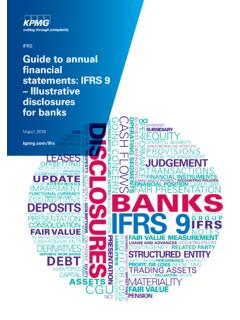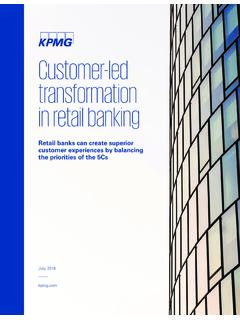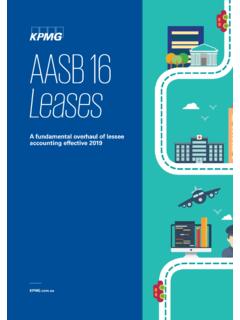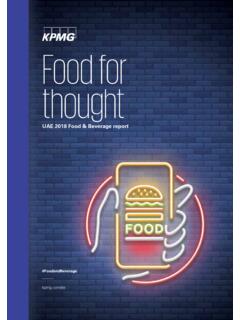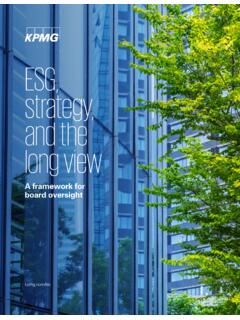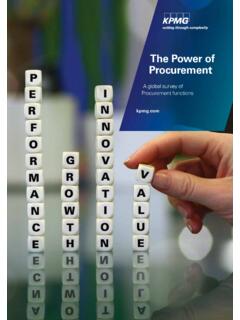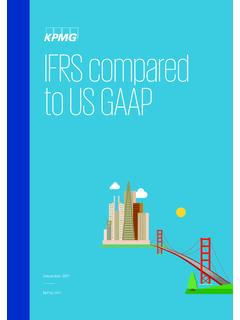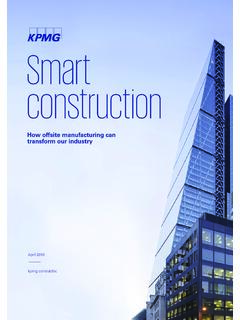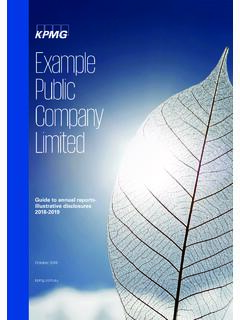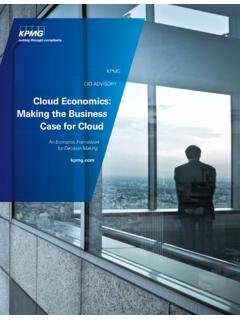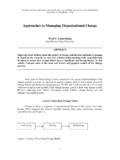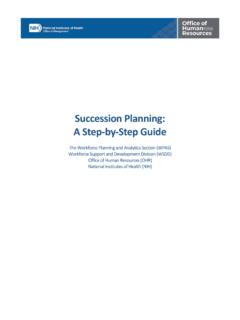Transcription of Top 15 Risks In Retail 2017
1 Top Risks In Retail 2017 2016 KPMG LLP, a Delaware limited liability partnership and the member firm of the KPMG network of independent member fir ms affiliated with KPMG International Cooperative ( KPMG International ), a Swiss entity. All rights reserved. 2 RiskDescriptionPoints to ConsiderCompetitionIntense competition on a national and international level both in the and retailers offer the same or similar merchandise and compete on the basis of price, quality, or speed to market. Competitors may have greater resources or evolved business models that provide a better shopping of entry into the marketat all time low, while a large numberof niche players driving change. Pricing and promotional strategy (new normal?) Physical and virtual locationarbitrage Business model differences based on culture, Retail sub channel and history Impact of mobile commerce / social media Globalized Retail markets and foreign Retail entry into Cost of delivery expectations Impact and growth of a more socially conscious shopper Pop up stores and lower cost of concept and entry Next big thing (VR etc.)
2 ConsumerTrends / PreferencesCustomer is the new point-of-sale. For today's connected consumer, the shopping 'experience' can be half of consumers actually enter Retail stores. Shopping experiences that are meaningful, memorable, shareable, and personalized maintain technology into a brand persona through influencer marketing can be a powerful tool in driving customer habits. Marketing must be relevant to the product offering and meet consumer needs. Brand building on the Retail front has become a team sport for many firms that are generating significant results via partnerships that deliver competitive advantages. Consumer products & Retail comprise roughly 20% of the US economy Nearly 40% of US households have Amazon Prime 40% of men and 33% of women aged 18 to 34 would buy everything online if they could 95% of Millennials want to build meaningful interactions with brands on social media Amazon is #1 in customer satisfaction among both online and store-based retailersGeneral EconomicConditionsGDP growth below expectations for first half of year, primarily due to impact of oil and gas to see slow but steady growth in the US economy over next 2-3 yearsRetail sales annual growth has decreased every year over the last 5 years from 7% to consecutive months of jobs growth in for transformation is of platform companies in unexpected areas (Google in healthcare etc.)
3 Interest rates expected to stay the same until impacting consumers perception and economic conditions include: Impact of contentious Presidential election Regional unemployment levels Government gridlock Impact of government spending, and tax policy Minimum wage increasesImpact of changing economy (manufacturing based hasmoved to service and technology based)Brandand ReputationRetailers run the risk that one innocuous post/video/comment from any angle (Board, customer, associate, management) could trigger a significant brand protection situation which impacts sales or customer volumeof consumer touch expansion of social to build reputation and seconds to happen anywhere in chain. Most retailersreact to situations asthey happen. Need to proactively have plans in place Types of branddamage Long / slow / denial Sears Immediate Target Cyber Continuoushits-- Chipotle Increase of disaster recovery plans for Brand situations Monitoringofconsumer sentimentTransformation RiskChange fails when programs are exclusively focused on the technical excellence of the of failure increases if people and organizational resistance to change is not proactively cause of transformation issues: Project management problems (32%) Failure to define objectives (17%) Lack of communication (20%) Inexperience in scope and complexity(17%) Technical Issues (14%)Top Retail Risks for 2017 2016 KPMG LLP, a Delaware limited liability partnership and the member firm of the KPMG network of independent member fir ms affiliated with KPMG International Cooperative ( KPMG International ), a Swiss entity.
4 All rights reserved. 3 RiskDescriptionPoints to ConsiderSecurity of Customer & Personal Information Risk of security breaches of business and customer data through cyber-attacks from hackers and sophisticated in control structure due to reliance on 3rd party of significant business impact of key systems not being available (websites, core operating systems, e-mail etc. through methods such as Denial of Service attacks and others). Rise in regulationsaround cyber compliance leadership and governance Human factors Information risk management Cybersecurity, business continuity and crisis management Operations and technology Legal and compliance Back up and supportCompliancewith RegulationsIncreased regulation pertaining to operations, product liability, competition,consumer protection, price controls social and environmental considerations. More proactive adherence to compliance will be necessary. Litigation against retailers is rising ( class actions).Litigation areas are extensive and require strong business controls and experienced legal departments.
5 New revenue recognition and lease accounting rules NewISO 37001 Anti-Bribery Management System standard will be published and available for certification FCPA/UK Bribery Act Healthcare reform impact Labor compliance (Min wage, FLSA, Minors, California) ADA impact on Omnichannel Corporate social responsibility and controlsat partners SOX and PCAOB changes Class action lawsuits due to performance, compliance breach or other International compliance for productsafety, labor, pricing Disruption and ChangeSignificant risk exists in the management of rapidly changing IT infrastructure due to the growing importance of technology and strategic shift in speed of technology temptation to continuously, incrementally improve legacy systems - beyond what is truly broken or required by regulation - is ongoing and often results in adding technical debt to already arcane infrastructure. Aligning inventory, pricing, and customer systems is a must to deliver a seamless customer experience.
6 Updating POS to support transactions through all mediums Mobile POS/re-platform of e-commerce and growth of use Technology framework dilemma (ERP v best of breed) Explosion of cloud based solutions Expanded software licensing reach Technology migration towards connected customer (loyalty programs linked with sales and social media) Rapid evolution of consumer technology Best of Breed vs. Integrated Enterprisetools Ensure technology strategy / spend support the overall business strategyAttract & Retain PersonnelLoss of critical resources that will impact the business ability to deliver customer service, business results and stakeholder personnel changes at executive levels lead to gaps in ability to define and execute strategy. Tempworkers hired earlier this season Compensation and benefits Work/life balance Clearly defined job descriptions and paths to promotion succession planning and bench strength Corporate culture and expectations vs. connected culture Talent management Training and development best practicesTaxationA large percentage of retailers don t realize the full potential of their transformation efforts due to a lack of clarity about the role of tax and how it fits in.
7 Failure to include tax at the table during transformationalefforts diminishes the effectiveness and efficiency of the transformation agenda in any retailer, regardless of the size or scope of the organization or its transformation. Global tax impacts of new business structures giving balanced consideration to tax efficiency and tax risk State and local tax effects of new business strategies and structures, includingcompany expansion into additional localities Implement the right tax structuring to maximize the long-term value of global growth Weigh the potential tax Risks and benefits of contemplated transactions including transfer pricing, the new BEPS guidance, and local country tax requirements Transform the internal tax function to support an expanded business footprint Consider state and city economic business incentives Ensure tax and human resource departments are aligned when moving global talentTop Retail Risks for 2017 2016 KPMG LLP, a Delaware limited liability partnership and the member firm of the KPMG network of independent member fir ms affiliated with KPMG International Cooperative ( KPMG International ), a Swiss entity.
8 All rights reserved. 4 RiskDescriptionPoints to ConsiderOmni Channel and 21stCenturyRetailingCustomers gravitate to retailers that provide the best and most consistent multifaceted experience based on their quality/value perspectiveIt snot yet clear what the next trigger point for transformation in Retail will be, however, it will occur in the next 5-10 years (VR, self driving cars, embedded communication, etc.) Consumer technology again evolvingrapidly Customer engagement or conversation instead of transaction (one view of customer) Updating of infrastructure and merchandising systems Establishing enterprise inventory (one view of inventory) Expanding mobile purchasing Strategic revision of critical areas for a retailer: channel mix management, brand experience delivery, merchandising, communication, personalization of shopping, communication,offers, transaction processing, inventory management, logistics, forecasting, incentive alignment and customer profilingPricingCustomers expectations on pricing are changing.
9 Retailers often go all out featuring the lowest prices or best bargains. While the discounting pulls in new customers, it also erodes retailers focus less on deep discounts and more on customer experience. They also turn to dynamic or time-based pricing - sophisticated algorithms and computing programs to monitor real-time prices on items sold by competitors Analytics and IT platforms that tap into ebbs and peaks of consumer activity help retailers make informed and timely decisions regarding competitive pricing strategies much better than tradition or existing policies: Amazon uses dynamic pricing and conducts price changes on average every 10 minutes Walmart uses dynamic pricing to make over 50,000 price changes monthlyChallenges include: the disconnect between localized store pricing and web based pricing, The direct relationship between Inventory management practices and pricing Competitive movement Undercutting from suppliers with Retail outlets Impact of total price consideration for a customer (includes cost of product, cost of delivery (free shipping), cost of return, ease of return and previous experience)Data and InsightBig data has long been touted as the next big transformation point, however, this has not yet occurred in mainstream Retail .
10 While retailers capture a large amount of data on customers, purchases, and trends, few have leveraged this to be able to form valuable insight that gives them an edge. The issues are exacerbated by recent implementation of omnichannel fulfillment strategies without adequate thought on the data and reporting needs that come out of new processesData overload has become a problem in Retail Whatis your data strategy? Howdoes this tie in with your overall strategy? How trusted is the data that comes out of your organization? How do you know? What data governance steps have you put in place? Does your whole organization have consistent base definitions that everyone follows (Sales, profit, margin) How much time does your team spend vetting data and reports in stead of analyzing them? What are the insight levers that within trigger directional change in your organization? If you don t have them, why not?International Business RiskDifferences in cultural and economic conditions between the and other countries can form significant barriers to entry for of understanding of country nuances where retailers are expanding can quickly result in significant costs and divert resources from other strategic initiatives.
